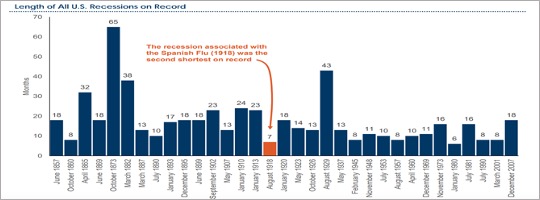The past three months in the capital markets can be described as a) bone-chilling, b) disturbing, c) anxiety-inducing or d) all of the above? Take your pick, Q1 of 2020 will be one for the history books. Beyond the devastating impact to the health and safety of populations around the globe, the unforeseeable damage to the capital markets and economy have already been severe. The term for these rare events is a “black swan.” We are sure to see significant deterioration in economic data in the coming months and the length and severity of this long awaited recession and bear market will likely be dependent on two questions: How soon will the economy begin opening back up for business, and how soon will the coronavirus be addressed with therapeutics, testing, and a “flattening of the curve.”

The peak to trough drawdown was incredibly rapid and breathtaking. The chart below is the same group of indices from above, illustrated from the peak of February 19th to the recent low of March 23rd. The market’s plummet was one of the worst and most rapid in history with comparisons to Black Monday in October 1987 and the Great Recession in 2008-2009.

State of the Economy
Through the first several weeks of 2020, the U.S. economy was chugging along at a 3%+ rate of GDP, the manufacturing slump from 2019 was improving, the housing market was strong, the unemployment rate was the lowest in over 50 years and consumer spending & confidence were at extremely high levels. The questions in everyone’s mind were: “How long could this economic expansion last? What would be the trigger to start the next recession? Would it be a policy error? Would it be the 2020 election outcome? Well, we now know the answer. The culprit was a worldwide pandemic named COVID-19.
With the prospect of voluntarily shutting down the economy, panic ensued. The Fed acted rapidly, dropping the Fed Funds rate to 0% and the government began passing fiscal stimulus packages to backstop the income of U.S. citizens, small businesses, the credit markets, the housing market, you name it. This is really a race against time; it’s the economy reopening versus getting the virus under control with therapeutics and eventually a vaccine. There are parts of the economy that are stable and even stronger than before; certain software companies, groceries, health care/biotechnology, while other areas like retail, restaurants, travel and tourism are getting crushed. The consensus is that we are already in a recession (2 consecutive quarters of negative GDP). Q1 of 2020 should show a negative reading that will be understandable and acceptable, while Q2 will be so bad that it might sting a bit. The silver lining of this story is that the economy will most likely recover fairly quickly once it is safe to go back to work. Ideally, the shape of the recovery will be a “V” rather than a “U.” The V-shaped recovery would be a tremendous snap back of economic growth after a very short recession, while the U-shaped recovery would be a longer economic lull ultimately leading to recovery.
The following 3 year chart illustrates the sharp rise in unemployment claims and the corresponding downturn in sentiment at the very end of the quarter. As more data roles in, these readings will get worse as we slide into what might turn out to be a deep, but short-lived recession.

The chart on the following page illustrates the length of time in months each U.S. recession lasted all the way back to the mid-1800’s. Interestingly, the second shortest recession on record was associated with the 1918 Spanish flu and lasted 7 months.

Equity Markets Overview
During a bear market associated with a recession, it is typical that equity markets bottom during the trough economic quarter. The consensus is that Q2 will be the trough quarter with GDP dropping by double digits. Thus far, the market bottomed on March 23rd. It is quite possible that we’ve already seen the bottom in the stock market based on the initial sheer panic and uncertainty of the situation. It is also possible and historically normal that after a big reflex market rally for the market to drift lower in a more orderly manner and “retest” the initial low. Regardless, we expect more choppy market action over the next few months as corporate earnings and economic data are reported. In the meantime, our portfolios have been adjusted toward companies and sectors with a greater focus on technology, communication services and health care that can capitalize on the “new abnormal.”
According to Tony Dwyer, Sr. Managing Director, Macroeconomist, & Chief Market Strategist with Canaccord Genuity, the 3 typical phases of a bear market crash are:
- Panic Low – big market drop with high volatility
- Multi-week relief rally
- Frustration – drift lower after multi-week rally to retest the original panic low
At this point, our research which includes white papers, articles, analyst interviews and conference calls point to an earnings contraction of -15% to -25% for the full year 2020. According to Brian Wesbury, Chief Economist with First Trust, earnings should contract by approximately 25% in 2020 while the market has priced in a 50% drop in earnings, meaning that the recent market drop was overdone based on panic.
Lastly, it is worth noting that the market is a forward pricing mechanism, meaning that once the bad news is “baked in the cake,” the market will begin pricing in the recovery; the market always turns upward before recessions come to an end.
Fixed Income Overview
Reminiscent of 2008-2009, bond investments correlated with equities over the short-term and took a big leg down as there was a cash liquidity event. The exception to this dynamic was low-yielding U.S. Treasury bonds. Within a week of this bond market drop, the Fed stepped in and began a series of aggressive lending facilities to support the credit markets. So far, so good; bond prices have begun to stabilize and decouple from equity price movements. Essentially, investment grade debt has begun to once again act like a ballast and diversifier against the stock market.
Below is a chart of various bond asset classes starting from the stock market’s high-water mark of 2/19/2020. Notice how Treasuries held up very well, while all other bond assets realized steep drops in value. During the last week of the quarter, as the stock market bottomed on March 23 and started to rally, corporate bonds, municipal bonds, and high-yield bonds also rallied, while Treasuries flatlined.

Here is the same chart, showing just the last week of the quarter, after the market bottomed and the new supportive Fed policy was in the books.

As we transition into the second quarter of 2020 and the first recession in 11 years, there is plenty to worry about, but there is also reason for optimism. As positive developments with this pandemic are revealed and as the economy begins to re-open, we are confident that the capital markets will normalize and equity markets will reach new all-time highs in the next couple of years. In the meantime, focus on your family, health and safety. As one of our long term clients that recently passed away always said, “If you have your health, you have your wealth!”


